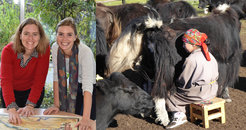International Women's Day 2018 at the MPI-SHH
This month we will be highlighting female employees and their work, beginning with Director Nicole Boivin of the Department of Archaeology.
Check back here throughout the month for updates!
“Pristine landscapes simply do not exist and, in most cases, have not existed for millennia.”
Dr. Nicole Boivin, Director, Department of Archaeology

Dr. Boivin has had a vibrant and exciting career. One her most significant contributions to archaeology is her work to bridge the traditional divide between the natural sciences and humanities, exploring the entanglement of biological, cultural and ecological processes from prehistory to the present. Dr. Boivin is interested in human history over the long-term, and the broad patterns of migration, interaction and environmental manipulation that have shaped the human story, and her work on human impacts on the environment has been redefining our understanding of the Anthropecene.

Her primary geographic areas of research are South Asia, Arabia, East Africa and the Indian Ocean. Her most recent ERC funded project Sealinks investigated the emergence of long-distance trade and connectivity in the Indian Ocean, and its relationship to processes of biological exchange and translocation.
Dr. Boivin is author of Material Cultures, Material Minds: The Role of Things in Human Thought, Society and Evolution (2008, Cambridge University Press). She is editor of several books, most recently Human Dispersal and Species Movements: From Prehistory to the Present (in press, Cambridge University Press).
As director of the Department of Archaeology, Dr. Boivin has been a strong advocate for women in archaeology, resulting in a strong gender balance in the department. She serves as a mentor for early career scholars, promoting work-life balance and paving new avenues for women archaeologists from different backgrounds.
For more information on Dr. Boivin’s work and her department's current projects, please click here.
Juliane Bräuer, head of the DogStudies group, Department of Linguistic and Cultural Evolution

Dr. Bräuer has conducted numerous studies on animal cognition and comparative psychology, including extensive work with dogs and wolves.
Read more about her recent study on dogs’ mental representations based on smell “A ball is not a Kong: Odour representation and search behavior in domestic dogs of different education” here.
You can also sign your dog up for participation in DogStudies research here!
Marieke van de Loosdrecht, PhD researcher, Department of Archaeogenetics

She is part of the team that reconstructed the genomes of ~15,000 year old hunter-gatherers from North Africa, published in Science. These genomes are by far the oldest recovered from the African continent and provide a first insight into the Late Stone Age genetic history of this region.
Read more about the publication here!
Jana Zech, Lab Manager of the Stable Isotope Research Group, Department of Archaeology

Dr. Zech is committed to developing and applying novel stable isotope methodologies (such as compound specific isotope analyses of sediments, artefacts and bones) in the study of the human past. In particular, she facilitates the use of isotope methodologies in the study of intra- and inter-societal differences in prehistoric and historical human diets, the development of detailed human stable isotope ecologies, and the development of new, detailed palaeoenvironmental proxies of immediate relevance to studies of past human responses to climatic and environmental change.
Read more about Dr. Zech’s work here!
Samantha Brown, PhD Researcher for the FINDER project, Department of Archaeology

Samantha’s research is focused on the discovery of Denisovan bones, an important ancient ancestor known only from the remains of three teeth and one tiny bone. Fragmented bones from key sites which Denisovans were believed to have occupied will be analysed through a range of techniques, including Zooarchaeology by Mass Spectrometry (ZooMS) which allows for the identification of fragmented bones through the analysis of their collagen. After their initial identification, the Denisovan bones can then be studied using radiocarbon dating, stable isotope analysis, and DNA analysis.
Read more about her research here!
Christina Warinner, W2 Group Leader, Department of Archaeogenetics
Jessica Hendy, Group Leader, Department of Archaeology

Their project, Heirloom Microbes, is tracing the relationships between bacteria in traditional dairy products around the world.
Microbes are an integral part of our cuisine, and are especially integral to dairy products. In this project the researchers are combining archaeology, microbiology, food science, and cultural anthropology to gain insight into dairying practices, microbial diversity, and the impact that microbes have had on our foods, our biology, and our society today.
Read more about the project here!
Alicia Ventresca Miller, postdoc researcher, Department of Archaeology

Her project, the Hungry Steppe, examines the emergence of proto-urban centers in central Eurasia. The aim of the project is to demonstrate the resilient strategies used by pastoral groups in prehistory through investigation of a regional center in central Kazakhstan.
Read more about the project here!
Elizabeth Nelson, PhD student researcher, Molecular Paleopathology group, Department of Archaeogenetics

Her project, Tuberculosis in Huari, Peru, focuses on the evolution and ecology of Pre-Columbian tuberculosis in the Peruvian Andes during the decline of the Wari Empire in the 11th century CE, and the 300 years after imperial collapse. Her research is in collaboration with Dr. Tiffiny A. Tung of Vanderbilt University and is part of that larger NSF-funded research project, “Imperial Decline and Climate Stress: A Bioarchaeological and Isotopic Study of Social Organization, Violence, Health and Diet in the Post-Wari Era, Ayacucho, Peru”. Her research on tuberculosis at Huari is a component of the research program “Ancient Tuberculosis in the New World and Beyond”.
For more information on this collaborative project, please click here!








